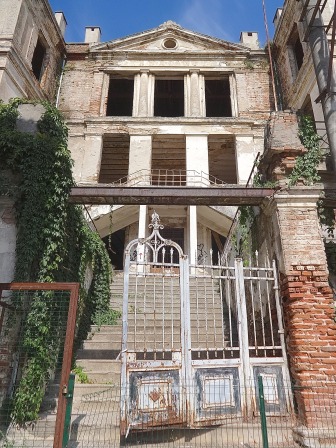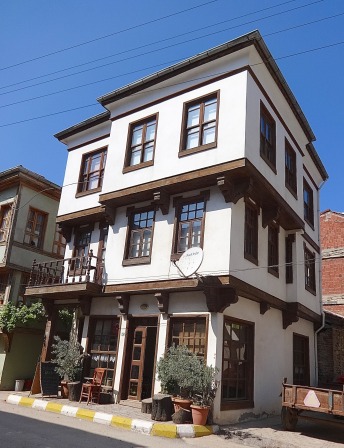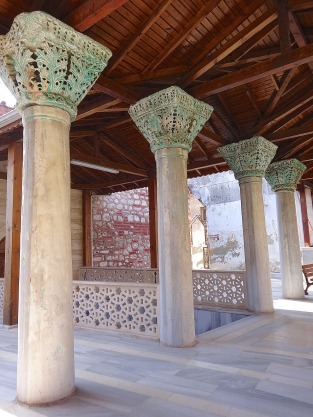In his youth, I think, Hasan must have been something of a heart-stopper. Even now in his fifties he seems wholly at ease in his body in a way that only those who know themselves to be good-looking ever truly are. Ahead of me he strides, back held straight and proud, keen to show off his own little corner of Turkey, so near to İstanbul yet somehow so completely overlooked by the outside world.
In the courtyard of the Ulu Cami he ushers me to a seat in the shade and in the tone of a true Atatürkist chides me for pulling out and donning a headscarf. “It’s not needed,” he says. “We don’t require it.”
As he chats I start to remember my last visit to Trilye. On that occasion I’d looked on the conversion of this Byzantine church into a mosque with a particularly jaundiced eye. Unkind was the gentlest word I could find to describe what had been done to its lovely, crumbling stonework. Despite its great age, somehow Joe Local Builder with his hod full of concrete had been allowed to come along and outline every single stone with a hard rim of red. For good measure he or his equally aesthetically challenged brother had also been allowed to slop green paint over the glorious Byzantine capitals that topped the pillars of the portico. It was a shame, a disgrace. Words failed me, frankly.
But now Hasan threw open the door and ushered me inside. “Küçük…” he started before I finished the sentence for him: “Ayasofya”! For at first glance the similarity to the sublime architecture of the Emperor Justinian’s first church in Constantinople was staggering. At second glance inevitably the impression slipped away again. Kücük Ayasofya was a church in the round with an upper gallery round which still runs an inscription in elegantly carved Greek letters. In Trilye the ground plan is a much more familiar cross, the gallery a mere mirage. Still, it had to be more than chance that had caused us both to hit on the same analogy spontaneously.
We head out from the mosque-church into the sun-splattered street. It being Monday morning not much is stirring, the owners of the many shops selling olive-oil in chi-chi packaging knowing that, with the weekend behind them, they might as well take their time about laying out their stock for the stragglers. Hasan rattles along the road though.
 “This was the old post office,” he says, pointing to a triple-decker house whose weatherboarding, while glittering white in places, is cracked and rippling in others. The shops on the ground floor are boarded up but at least there are occupants.
“This was the old post office,” he says, pointing to a triple-decker house whose weatherboarding, while glittering white in places, is cracked and rippling in others. The shops on the ground floor are boarded up but at least there are occupants.
Across the street he points out the house of Filip, the Greek olive-oil merchant whose ships, he says, had sailed as far as Marseilles. Then we arrive at the foot of the steps leading up to the Taş Mektep, the enormous school built by the Greek priests in the days when Trilye was home to three times as many people as it is now, at least a third of them Christian. The gates are locked, lopsided, broken. We try again from the side and, through the broken windows, glimpse graffitied walls, litter on the floor.
“This was where I went to school,” says Hasan. “There,” – he points at a rectangle of white on the wall – “was where the teacher used to write.”
 Round the corner we come across a woman stirring salça in twin cauldrons. She flees in horror at the very idea of a photograph although her husband steps into the breech, giving the tomato mix a quick whirl with a wooden paddle. His wife has retreated into a newly renovated house with potted plants thick against its shutters.
Round the corner we come across a woman stirring salça in twin cauldrons. She flees in horror at the very idea of a photograph although her husband steps into the breech, giving the tomato mix a quick whirl with a wooden paddle. His wife has retreated into a newly renovated house with potted plants thick against its shutters.
“That used to be the simit shop,” Hasan told me. “That’s where I’d stop to buy a simit on the way to school.” Until last year the man and his salça-making, photo-shy wife used to live in the Byzantine church known locally as the Dundar Evi. Now apparently it’s been sold.
“What will happen to it?” I ask.
Hasan shrugs. “A hotel?” We both laugh although not in a very nice way.
Down the hill we go again, passing a double fountain recently given a dazzling coat of whitewash. Two Roman gravestones have been inserted as backing for the taps.
 “This is where I’d stop for a drink on the way back from school,” Hasan says. He’s sniffy about its new look although I don’t mind it much. I think I’ve probably been living here for so long now that my eye is learning to be a little more forgiving.
“This is where I’d stop for a drink on the way back from school,” Hasan says. He’s sniffy about its new look although I don’t mind it much. I think I’ve probably been living here for so long now that my eye is learning to be a little more forgiving.
Finally we stroll behind the mosque into Dutlu Sokağı (Mulberry Street). There’s a hamam on the corner, newly restored regardless of whether anyone will ever use it again.
“I came here all the time as a child,” Hasan says. “For 20 years. Every weekend.”
Then he turns to the shattered relics of a warehouse that face the mosque. It was here, he tells me, that the Greeks would bring the silk cocoons reared in their mulberry orchards.
“Then they’d be loaded onto the horse carts for the journey to Bursa,” he says. His eyes grow misty. “The silk road…” And we both let out a sigh.
Written: 20 January 2015


